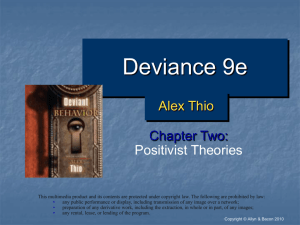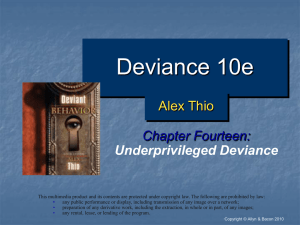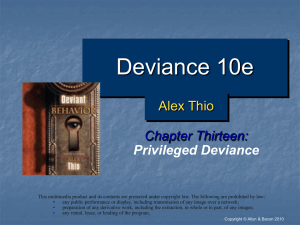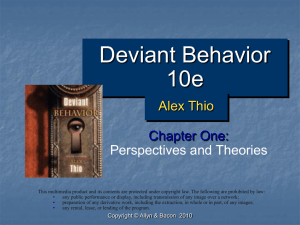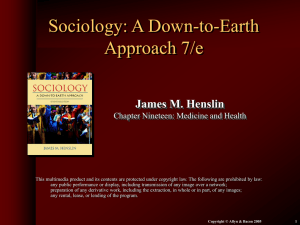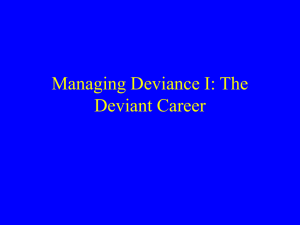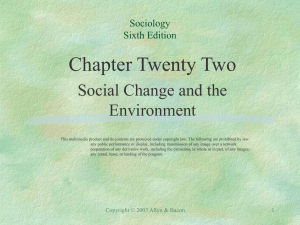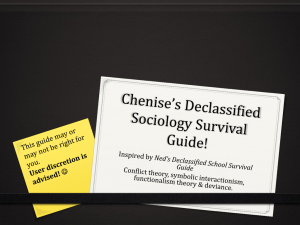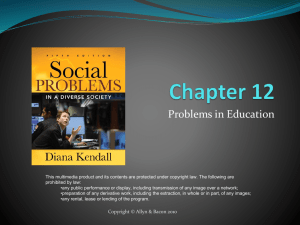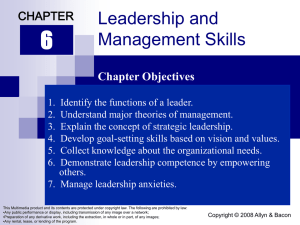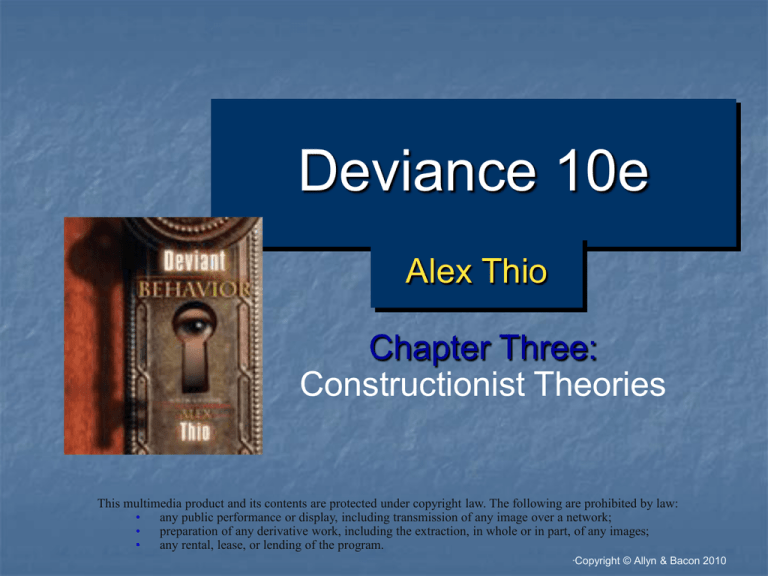
Deviance 10e
Alex Thio
Chapter Three:
Constructionist Theories
This multimedia product and its contents are protected under copyright law. The following are prohibited by law:
•
any public performance or display, including transmission of any image over a network;
•
preparation of any derivative work, including the extraction, in whole or in part, of any images;
•
any rental, lease, or lending of the program.
“
Copyright © Allyn & Bacon 2010
Introduction
Constructionist theories of deviance are
less interested in causes and concentrate
on the meanings of deviance and how
people behave in keeping with those
meanings
“
Copyright © Allyn & Bacon 2010
Labeling Theory
Labeling theory: a version of symbolic
interactionism; emphasizes importance of
labeling
Two central ideas:
Deviance involves interaction between deviant and
conventional people
Interaction between the deviant and the conformists is
governed by the meanings that they impute (assign)
to each other's actions and reactions
Causes of deviant behavior are not important;
only the labels are important
“
Copyright © Allyn & Bacon 2010
Labeling Theory – cont.
Labelers represent: law and order (police, judges, prison
officials, etc.) and conventional morality; power
(generally are rich and white); and have the ability to
avoid negative labels despite engaging in deviant
behavior
Deviance labels produce negative consequences for
those receiving the label:
tendency to see themselves as deviant
Which leads to continued deviant behavior
Lemert: primary (initial act of deviance that occurs before
a deviance label is applied or accepted) vs. secondary
deviation (continued deviance that results from deviance
labels being applied and internalized by the social actor)
“
Copyright © Allyn & Bacon 2010
Labeling Theory – cont.
Erikson: deviance creates positive
consequences for the community, group, or
individuals that apply the label – the most
important being preservation and strengthening
of social cohesion and social order.
Criticism of labeling theory:
can’t explain causes of deviance
deviant label does NOT encourage further
deviance
underestimates role of powerful
“
Copyright © Allyn & Bacon 2010
Phenomenological Theory
Delves into people's subjectivity, including
their consciousness, perceptions,
attitudes, feelings, and opinions about
deviance
Critical of positivists – deviance based on
their (the positivist’s) own preconceived
notions of morality and understanding of
deviance
“
Copyright © Allyn & Bacon 2010
Phenomenological Theory – cont.
Positivists: humans are passive objects whose
behavior is determined by forces beyond their
control
Phenomenologists: people are active subjects
capable of intending and carrying out their own
behavior
Positivists: objective view, based on abstract
meanings
Phenomenologists: study situated meanings and
the subject's interpretation of their own behavior
“
Copyright © Allyn & Bacon 2010
Phenomenological Theory – cont.
Use of ethnography (applied
phenomenology) - how deviants see and
feel about themselves
Garfinkle: study of sex change patients
Katz: study of murders/robbers
Criticism of phenomenologists:
Failure to develop a practical way to
understand deviance
Influenced by their own beliefs, judgments,
and ideas
“
Copyright © Allyn & Bacon 2010
Conflict Theory
Modern society is pluralistic, diverse, and
full of conflicts
Social conflict: incompatible interests,
needs, and desires of diverse groups
Cultural conflict: discrepant norms and
values regarding right and wrong
Both lead to crime
“
Copyright © Allyn & Bacon 2010
Conflict Theory – cont.
Chambliss: identified the difference between the
law on the books and the law in action
Enforcement of law is often unfair
Interests of ruling class is strongly favored
Quinney: blames unjust law on the capitalist
system
calls for political action against the powerful class who
inevitably criminalizes the powerless – “Marxist
Theory”
“
Copyright © Allyn & Bacon 2010
Figure 3.1 Quinney’s Social Reality
Theory
“
Copyright © Allyn & Bacon 2010
Conflict Theory – cont.
Marxist theory: deviance is caused by the
exploitative nature of capitalism
Feminist theory: theories of deviance are
primarily about men and not women
Power theory: emphasizes how power
inequality (disparity) affects deviance
Powerful are more likely to get involved in
profitable deviance than the powerless
who engage primarily in less profitable
“
Copyright © Allyn & Bacon 2010
Conflict Theory – cont.
Postmodernist theory: criticizes the
positivist search for objective truth and
deconstructs, or analyzes phenomena to
understand their component parts, in the
same way phenomenologists try to reduce
subjective experiences
“
Copyright © Allyn & Bacon 2010
Conflict Theory – cont.
Criticism of conflict theory:
Can’t explain common-law crimes and vices
Wrong in assuming that a utopian, socialist
society would be free of deviant behavior
“
Copyright © Allyn & Bacon 2010

